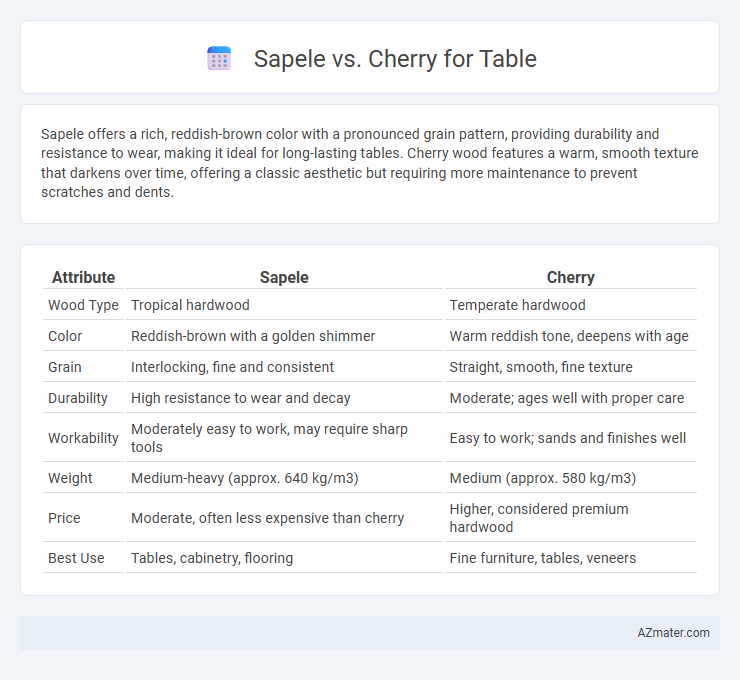Sapele offers a rich, reddish-brown color with a pronounced grain pattern, providing durability and resistance to wear, making it ideal for long-lasting tables. Cherry wood features a warm, smooth texture that darkens over time, offering a classic aesthetic but requiring more maintenance to prevent scratches and dents.
Table of Comparison
| Attribute | Sapele | Cherry |
|---|---|---|
| Wood Type | Tropical hardwood | Temperate hardwood |
| Color | Reddish-brown with a golden shimmer | Warm reddish tone, deepens with age |
| Grain | Interlocking, fine and consistent | Straight, smooth, fine texture |
| Durability | High resistance to wear and decay | Moderate; ages well with proper care |
| Workability | Moderately easy to work, may require sharp tools | Easy to work; sands and finishes well |
| Weight | Medium-heavy (approx. 640 kg/m3) | Medium (approx. 580 kg/m3) |
| Price | Moderate, often less expensive than cherry | Higher, considered premium hardwood |
| Best Use | Tables, cabinetry, flooring | Fine furniture, tables, veneers |
Introduction: Sapele vs Cherry for Table Making
Sapele and cherry are both popular hardwood choices for table making, valued for their durability and aesthetic appeal. Sapele features a rich, reddish-brown color with an interlocking grain pattern that adds unique texture and strength to furniture surfaces. Cherry wood is prized for its smooth grain and warm, reddish tone that deepens with age, providing a timeless and elegant finish for high-quality tables.
Wood Appearance: Sapele vs Cherry
Sapele wood exhibits a rich, reddish-brown hue with a distinctive interlocking grain pattern that creates a shimmering, ribbon-like effect, making it visually striking for furniture. Cherry wood features a warm, reddish tone that deepens to a rich reddish-brown patina over time, offering a smooth and fine grain with occasional natural knots. Both woods present unique aesthetic qualities: Sapele's vibrant, complex texture contrasts with Cherry's consistent, elegant grain and color evolution.
Hardness and Durability Comparison
Sapele wood has a Janka hardness rating of approximately 1,410 lbf, making it moderately hard and suitable for durable furniture like tables. Cherry wood, with a Janka hardness rating around 995 lbf, is softer but still offers good durability for indoor use. Sapele's higher hardness translates to better resistance against dents and scratches, making it more durable than cherry for heavily used tabletops.
Workability and Machining Characteristics
Sapele wood offers excellent workability with a smooth, interlocked grain that resists splitting and is easy to machine, making it ideal for detailed woodworking and precise joinery. Cherry wood, prized for its fine, straight grain and consistent texture, machines smoothly and sands to a satiny finish, enhancing its appeal for high-end furniture tables. Both woods respond well to shaping and finishing, but Cherry tends to dull cutting tools slightly faster due to its density compared to the more resilient Sapele.
Cost Differences: Sapele vs Cherry
Sapele wood typically costs less than cherry, making it a budget-friendly option for table construction without sacrificing durability and appearance. Cherry wood commands higher prices due to its rich color, fine grain, and aging potential, which enhances the value of furniture over time. The cost difference between Sapele and Cherry can range from 20% to 50%, depending on the grade and source, affecting overall project expenses.
Finish and Aging: Color Changes Over Time
Sapele wood develops a rich, deep reddish-brown patina over time, enhancing its natural grain and giving tables a warm, elegant finish. Cherry wood darkens from a light pinkish tone to a rich reddish-brown with exposure to light, offering a smooth, lustrous surface that improves with aging. Both woods provide durable finishes that age gracefully, but Cherry's color transformation is more pronounced, often preferred for its classic, inviting warmth in furniture.
Sustainability and Environmental Impact
Sapele wood, sourced primarily from West Africa, is considered more sustainable due to managed forestry practices and faster growth rates compared to cherry, which is native to North America and often harvested from older, slower-growing trees. Cherry wood production can contribute to deforestation and habitat loss if not sourced responsibly, while Sapele's certification under FSC guidelines ensures reduced environmental impact. Choosing Sapele for tables supports eco-friendly furniture manufacturing by minimizing carbon footprint and promoting responsible forest management.
Maintenance and Care Requirements
Sapele wood requires moderate maintenance involving regular cleaning and occasional oiling to preserve its rich reddish-brown color and prevent drying or cracking. Cherry wood needs more frequent care due to its softer nature, including periodic polishing and protection from prolonged sunlight to avoid uneven fading and surface damage. Both woods benefit from controlled humidity environments to minimize warping and extend the lifespan of tables crafted from these materials.
Common Uses Beyond Tables
Sapele wood is widely used in cabinetry, musical instruments, and marine applications due to its durability and resistance to moisture, while cherry wood is favored for fine furniture, flooring, and decorative veneers because of its rich color and smooth grain. Both woods excel in interior architectural elements such as paneling, moldings, and staircases, with Sapele offering a more exotic reddish-brown hue compared to cherry's warm, reddish tone that deepens with age. Their versatility also extends to crafting musical instruments, with cherry prized for its resonance and Sapele valued for its stability and attractive figure.
Which Wood is Best for Your Table?
Sapele offers a rich, reddish-brown hue with excellent durability and natural resistance to wear, making it ideal for tables subjected to heavy use. Cherry wood provides a smooth grain and warm, deepening color over time, favored for its elegance and fine finish in dining tables. Choosing between Sapele and Cherry depends on your preference for durability and color evolution, with Sapele excelling in toughness and Cherry preferred for its classic aesthetic and aging beauty.

Infographic: Sapele vs Cherry for Table
 azmater.com
azmater.com